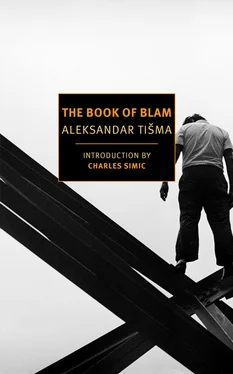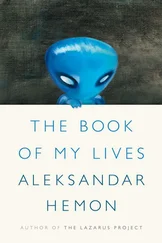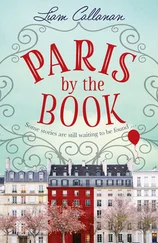Aleksandar Tisma - The Book of Blam
Здесь есть возможность читать онлайн «Aleksandar Tisma - The Book of Blam» весь текст электронной книги совершенно бесплатно (целиком полную версию без сокращений). В некоторых случаях можно слушать аудио, скачать через торрент в формате fb2 и присутствует краткое содержание. Год выпуска: 2016, Издательство: NYRB Classics, Жанр: Современная проза, на английском языке. Описание произведения, (предисловие) а так же отзывы посетителей доступны на портале библиотеки ЛибКат.
- Название:The Book of Blam
- Автор:
- Издательство:NYRB Classics
- Жанр:
- Год:2016
- ISBN:нет данных
- Рейтинг книги:5 / 5. Голосов: 1
-
Избранное:Добавить в избранное
- Отзывы:
-
Ваша оценка:
- 100
- 1
- 2
- 3
- 4
- 5
The Book of Blam: краткое содержание, описание и аннотация
Предлагаем к чтению аннотацию, описание, краткое содержание или предисловие (зависит от того, что написал сам автор книги «The Book of Blam»). Если вы не нашли необходимую информацию о книге — напишите в комментариях, мы постараемся отыскать её.
The Book of Blam — читать онлайн бесплатно полную книгу (весь текст) целиком
Ниже представлен текст книги, разбитый по страницам. Система сохранения места последней прочитанной страницы, позволяет с удобством читать онлайн бесплатно книгу «The Book of Blam», без необходимости каждый раз заново искать на чём Вы остановились. Поставьте закладку, и сможете в любой момент перейти на страницу, на которой закончили чтение.
Интервал:
Закладка:
BLAM WAKES UP.
In the final throes of his dream he is standing in front of a thick glass wall watching several figures twisting, writhing. Since the light is poor, he sees them as a blur of simplified forms, a skein of snakes crawling about with no direction or purpose. Yet he can somehow tell that they are people rather than snakes, and he senses that something terrible is going on there — pain, convulsions, death. Though horrified, he is also irresistibly drawn to the wall. He moves toward it with leaden steps, and the closer he gets, the clearer it becomes that there is in fact a tangled mass of human bodies on the floor behind it. Suddenly a figure detaches itself from the pile, rises to its knees, then to its feet, and reaches the wall at the same time as Blam. Blam stops, and the figure on the other side leans against the wall, pressing its hands and face to it. The hands squeeze out a blood-red color and gradually turn yellow; the face squashes flat, the nose broadening like a ripe fig, the mouth dividing into two leeches, the chin twisting into a pear, and finally the eyes meet the glass, two large goggle eyes whose eyeballs the pressure of the glass enlarges like water rings. The face, deformed as it is, looks familiar to Blam. He strains to connect its twisted features and faded complexion to something in his memory. His mind runs through the circle of his acquaintances and narrows until it comes to a point in the center and Blam realizes with amazement that the face is his own.
He awakes bathed in sweat, his heart pounding.
He is in his bed, which is near the window and criss-crossed by thin strips of light passing through the venetian blind to the wall, where Janja is dressing in their shimmer. He is struck simultaneously by three sensations. First, he fights the idea of waking yet welcomes it. He experiences waking as a lie, yet the dream that waking releases him from is also a lie. He is offended by the idea that one excludes the other. He still feels the horror of the dream’s image: the bodies intertwined, deformed by their suffering, with his among them. The suffering is real; he feels it inside him, in his short breath, his pounding heart, his cold sweat, and he senses, he knows that this is only the after-math of a whole dreamed life of suffering, which he no longer remembers and whose vestiges are fading, disappearing. He does not want them to disappear. If it is his life, he wants to keep it. On the other hand, his life also consists of waking in a cold sweat and watching a woman washed in light pull on her clothes and invite him into the shelter of the day.
Second, resolved as he is to take the inevitable step, Blam realizes how ill prepared he is. His heartbeat is fast and fitful, reverberating in his rib cage as in a barrel, and after every fifth or sixth beat a needlelike pain shoots through his chest. He assumes it is an echo of the fear he felt in the dream, though he has had similar pains lately even without such stimuli, walking along the street, sitting at his desk, or simply relaxing, lying on his back. Something inside him grinds to a halt or, just the opposite, starts up, an imperfection somewhere, a defect, a faulty cog on the body’s wheel designed to keep things running smoothly, to maintain the balance between effort and strength. Once the balance is gone, the heart holds back, then speeds needlessly forward, leaving him either racing after it frantically or waiting, petrified, for it to catch up with him. He is convinced that his arteries are obstructed and that the fitful, uneven beating may send him into convulsions or a stroke, that he will cry out and gasp for air, but there will be no air, and he will suffocate, flailing like a cat thrown into the water with a stone around its neck. Will it happen here, now? Blam pricks up his ears, as if death might announce its arrival with a special cry or alarm. He is paralyzed by the effort to forestall it. But how? Perhaps the thing to do is ignore its presence and devote himself entirely to life, perhaps it will spare him as long as he does that. So he fills his lungs and tries to breathe evenly; he trains his eyes and ears on life, on the far end of the kitchen, and the stitch in his chest does in fact ease gradually, his heartbeat grows slower, calmer, more regular.
But what he sees against the wall across the room only brings him new anxiety. The body bending over and straightening again, tall and supple — supple after all these years — the pink, sleek, supple body is the same as the one he saw from the tram, though then it was dressed in blue, with a bony, swarthy male arm around it. A hallucination? Perhaps, but so realistic, so like the image he had of her, that the vision instantly redefined and forever sealed their relationship. Like a symbol. Or a dream. Yes, like a dream more real than reality, deeper, sharper, since it is free of the intrusions of chance in the waking state. Like the dream he has just had. He is moving among dreams, from dream to dream, and everything not a dream is an illusion.
THE BLAMS’ HOUSE in Vojvoda Šupljikac Square was a modest, one-story building, a brick building, true, but with moisture stains on the walls, narrow windows that let in too little light, low, vaulted ceilings in the cellar, and a courtyard that miserly instincts had truncated to make room for a separate backyard apartment. The trapdoor leading to the cellar bent and groaned every time it was stepped on, the sun appeared over the black roof at noon only, and the privy, which stood between the front and back building, was without water.
The house had satisfied the Blams’ needs as newlyweds. They decided that rather than rent uncomfortable and costly rooms they would “put their own roof over their heads,” so they willingly invested the inheritance Blanka Blam had received upon the death of her mother, the widowed shopkeeper. Then, with the rise of the Novi Sad bourgeoisie — in which the Jews, with their worldwide family connections, played a leading part — the gap between what the house was and what it could be became more and more of an issue, and eventually a number of improvements were made. Vilim Blam, who assumed the role of designer, had a passion for the latest in everything, which came with his profession as journalist and with the long hours he spent at coffee houses. Blanka Blam, lacking in imagination and social contacts but hard-headed and determined, did her best to overcome all difficulties and put his ideas into practice. Blam liked nothing better of an evening than to have a cup of black coffee and a glass of red wine served in the dining room, to take out his pencil and sketch the plan of the house on the white pages of the notepad he carried in his pocket during the day for professional purposes. He would designate doors and windows with double perpendicular strokes, eliminate existing walls and draw in others, divide up or enlarge rooms, combine or separate hallways, and then, glowing with pleasure, call his wife away from the sink to have a look at his handiwork, annoyed if she, a dripping dish still in hand, failed to grasp the plan or show the proper enthusiasm. By the next morning he would forget the vision inspired by the wine and the evening hour, but she, who had only stood by with wrinkled brow, would remind him days or even weeks later of a detail that had in the meantime taken root in her mind, and ask him to call in workmen and set aside funds. Blam would put off the necessary negotiations and either forget to collect fees due him or spend them on the way home on gifts. Eventually, however, her repeated requests would bear fruit: the windows were replaced with new, larger, square ones, a glassed-in veranda sprang up in the courtyard, running water was installed to supplement the well, and — the pinnacle of modernization — a part of the unfashionably oversized pantry was turned into a bathroom.
Читать дальшеИнтервал:
Закладка:
Похожие книги на «The Book of Blam»
Представляем Вашему вниманию похожие книги на «The Book of Blam» списком для выбора. Мы отобрали схожую по названию и смыслу литературу в надежде предоставить читателям больше вариантов отыскать новые, интересные, ещё непрочитанные произведения.
Обсуждение, отзывы о книге «The Book of Blam» и просто собственные мнения читателей. Оставьте ваши комментарии, напишите, что Вы думаете о произведении, его смысле или главных героях. Укажите что конкретно понравилось, а что нет, и почему Вы так считаете.












